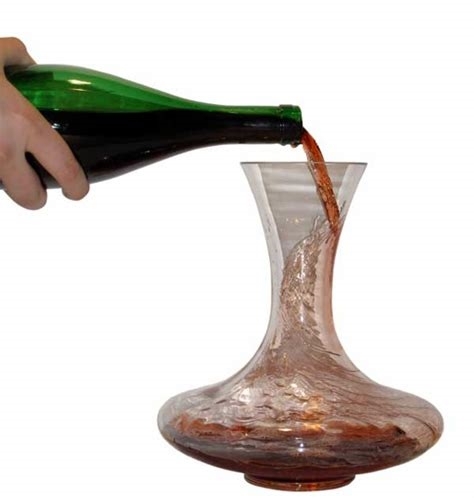
One of the most heated arguments among wine enthusiasts is not really about wine at all. It’s about whether you should pour it directly from the bottle into the glass, or whether you should first pour it into a decanter. Red wines that have been in the bottle for several years sometimes develop sediment. White wines rarely do, though tartrate crystals are sometimes found in older whites. There’s nothing wrong with sediment, it’s just the dead yeast cells and other tiny insoluble fragments that settle to the bottom of any wine container. However, it looks a bit unsightly and few people like to encounter black grit at the bottom of their glass. Decanting is the process of separating the wine from the sediment. But more of that in a moment.
Aeration is a simple process which enables the oxygen in the air to react with the wine and enhance the flavors and aromas. Some people (and many waiters) seem to believe that having opened the bottle, it should then be left to stand for a couple of minutes “to breathe”. This is nonsense, and I shall tell you why. When the bottle is standing on the table, only the wine in the narrow neck of the bottle is exposed to the air. This tiny surface area is far too small to make any significant difference. It’s better to simply pour the wine into the glasses and let it rest for a few minutes.
If you are at home rather than in a restaurant, you can aerate the wine by tipping the whole lot into a wine jug or decanter. But if you drink only a couple of glasses at a time rather than an entire bottle, consider buying a device called an aerator. There are two main types and both are inexpensive. One type is held above the glass while you pour the wine through it, but the process can be messy especially if your eyesight is not so good. It’s probably safer is to use the other type of aerator that fits into neck of the bottle and also acts as a stopper.
Aeration is something of a battle-ground among some wine experts. Professor Emile Peynaud, the distinguished French enologist believes that any oxygen damages wine and you should always pour wine straight out of the bottle into the glass. I have to say that few other experts would agree with him. I usually taste the wine first before I decide whether to aerate it. Nine times out of ten, I prefer aeration unless of course it’s sparkling wine which is never decanted nor aerated. If you use boxed wine, a decanter is pretty well essential. It doesn’t need to be an expensive one either. I use plain, simple glass decanters, made by Ocean and available at any decent kitchen shop for well under 100 baht each. They come in a variety of sizes. If you are sharing a bottle with two other people, you can pour the entire contents into three 25cl decanters. This ensures that everyone receives their fair share and avoids unseemly fist-fights later.
You don’t need to pour cheap wines gingerly as though they’re liquid gold, once you’ve got the top of the bottle over the decanter, just let the wine slosh in, so that the oxygen can really get to work. This is probably best done in the kitchen rather than at the table, in case you make a complete hash of it. And here you may detect the voice of experience.
Nearly all the world’s wine is made for early consumption and not intended for ageing, so sediment is unlikely in any wine you pick up at the supermarket. Unless you drink vintage port or old and expensive wines from Bordeaux, Burgundy or Italy you’ll probably never need to bother decanting. There’s no mystique in decanting, but it does require a little practice. If your wine has been stored horizontally (which it should have been) place the bottle upright at least a day before opening. This ensures that any sediment settles at the bottom. When you’re ready, gently remove the cork, grasping the bottle as steadily as possible. Then hold it over the neck of the decanter (the bottle, not the cork). Pour in the contents gently and steadily until the bottle is almost horizontal. As soon as you see sediment approaching the neck of the bottle, stop. It’s easier if there’s a bright light behind the bottle. Traditionally, a candle was used (no doubt with many cases of burnt fingers) but a small LCD torch is even better.
I suppose in the end, while decanting is a necessary chore for many older red wines, aeration is partly a matter of personal taste. If you prefer your wine tasting tight and firm, pour it straight from the bottle, but if you want it to open up a bit pour it first into a decanter or wine jug. You may want to use a decanter when the wine bottle has an especially ugly or cheap-looking label, or you may want to conceal the fact that you are dishing up cheap plonk. Far be it from me encourage dishonesty, but an elegant decanter will help to preserve your guilty secret.
 |
 |
 |





